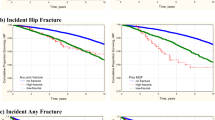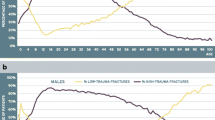Abstract
Summary
We investigated frailty and refracture risk among older adults with a minimal trauma fracture. After adjusting for age, sex, and site of initial fracture, increasing frailty was associated with an increased risk subsequent fracture. These results indicate the need to routinely screen for frailty following an initial fracture among older adults.
Introduction
Minimal trauma fractures are common among older adults, and frailty increases risk of an initial minimal trauma fracture. This study was undertaken to estimate the risk of subsequent fracture based on frailty status at the time of an initial fracture.
Methods
The study population was older adults presenting to hospital, aged 60 years or more, with a minimal trauma fracture. Frailty was estimated using a cumulative deficit approach. The risk of subsequent fracture based on increasing cumulative frailty deficit item group, adjusted for sex, age, and site of initial fracture, was estimated using Cox’s proportional hazard model.
Results
Between January 2014 and December 2020, 12,115 older adults presented to hospital (8371 women [69%]), with an initial minimal trauma fracture. The average age was 80 years (SD 9.5). Subsequent fractures identified during the follow-up period occurred in 1137 (9.4%) of study participants. The incidence of subsequent fracture ranged from 25.0 per 1000 older adults (95% confidence interval (CI) 22.4 to 27.8) among the lowest frailty deficit group (1 deficit item) to 31.8 per 1000 (95% CI 28.0 to 35.8) among the highest frailty deficit group (4 to 12 deficit items). After adjusting for age, sex, and site of initial fracture, an increasing number of frailty deficit items was associated with increased risk subsequent fracture (p-value for trend = 0.008).
Conclusion
Our results indicate that following an initial minimal trauma fracture, frailty independently increases the risk of a subsequent fracture. Therefore, it is important at the time of an initial fracture that older women and men are screened for the presence of frailty, and models of care are implemented to reduce the risk of subsequent fracture among this vulnerable group of older adults.

Similar content being viewed by others
References
Black DM, Cummings SR, Karpf DB, Cauley JA, Thompson DE, Nevitt MC, Bauer DC, Genant HK, Haskell WL, Marcus R, Ott SM, Torner JC, Quandt SA, Reiss TF, Ensrud KE (1996) Randomised trial of effect of alendronate on risk of fracture in women with existing vertebral fractures. Fracture Intervention Trial Research Group Lancet 348:1535–1541
Bliuc D, Alarkawi D, Nguyen TV, Eisman JA, Center JR (2015) Risk of subsequent fractures and mortality in elderly women and men with fragility fractures with and without osteoporotic bone density: the Dubbo Osteoporosis Epidemiology Study. J Bone Miner Res 30:637–646
Breslow NE, Day NE. Statistical methods in cancer research volume II: the design and analysis of cohort studies IARC scientific publication No. 82
Center JR, Bliuc D, Nguyen TV, Eisman JA (2007) Risk of subsequent fracture after low-trauma fracture in men and women. JAMA 297:387–394
Center JR, Nguyen TV, Schneider D, Sambrook PN, Eisman JA (1999) Mortality after all major types of osteoporotic fracture in men and women: an observational study. Lancet 353:878–882
Chen JS, Cameron ID, Simpson JM, Seibel MJ, March LM, Cumming RG, Lord SR, Sambrook PN (2011) Low-trauma fractures indicate increased risk of hip fracture in frail older people. J Bone Miner Res 26:428–433
Clegg A, Bates C, Young J, Ryan R, Nichols L, ANN TEALE, E., MOHAMMED, M. A., PARRY, J. & MARSHALL, T. (2016) Development and validation of an electronic frailty index using routine primary care electronic health record data. Age Ageing 45:353–360
Clegg A, Young J, Iliffe S, Rikkert MO & Rockwood K (2013) Frailty in elderly people. Lancet, 381 North American Edition, 752–762 11p.
Ensrud KE, Ewing SK, Taylor BC, Fink HA, Cawthon PM, Stone KL, Hillier TA, Cauley JA, Hochberg MC, Rodondi N, Tracy JK, Cummings SR (2008) Comparison of 2 frailty indexes for prediction of falls, disability, fractures, and death in older women. Arch Intern Med 168:382–389
Ensrud KE, Ewing SK, Taylor BC, Fink HA, Stone KL, Cauley JA, Tracy JK, Hochberg MC, Rodondi N, Cawthon PM, STUDY OF OSTEOPOROTIC FRACTURES RESEARCH, G. (2007) Frailty and risk of falls, fracture, and mortality in older women: the study of osteoporotic fractures. J Gerontol A Biol Sci Med Sci 62:744–751
Fried LP, Tangen CM, Walston J, Newman AB, Hirsch C, Gottdiener J, Seeman T, Tracy R, Kop WJ, Burke G (2001) Frailty in older adults evidence for a phenotype. J Gerontol A Biol Sci Med Sci 56:M146–M157
Harris ST, Watts NB, Genant HK, Mckeever CD, Hangartner T, Keller M, Chesnut CH, 3rd, Brown J, Eriksen EF, Hoseyni MS, Axelrod DW, Miller PD (1999) Effects of risedronate treatment on vertebral and nonvertebral fractures in women with postmenopausal osteoporosis: a randomized controlled trial. Vertebral Efficacy With Risedronate Therapy (VERT) Study Group. JAMA, 282, 1344-52.
Li N, Hiligsmann M, Boonen A, van Oostwaard MM, de Bot R, Wyers CE, Bours SPG, van den Bergh JP (2021) The impact of fracture liaison services on subsequent fractures and mortality: a systematic literature review and meta-analysis. Osteoporos Int 32:1517–1530
Lyles KW, Colon-Emeric CS, Magaziner JS, Adachi JD, Pieper CF, Mautalen C, Hyldstrup L, Recknor C, Nordsletten L, Moore KA, Lavecchia C, Zhang J, Mesenbrink P, Hodgson PK, Abrams K, Orloff JJ, Horowitz Z, Eriksen EF, Boonen S, Trial HRF (2007) Zoledronic acid and clinical fractures and mortality after hip fracture. N Engl J Med 357:1799–1809
Nguyen ND, Ahlborg HG, Center JR, Eisman JA, Nguyen TV (2007) Residual lifetime risk of fractures in women and men. J Bone Miner Res 22:781–788
R Core Team (2017) R: a language and environment for statistical computing. Vienna, Austria: R Foundation for Statistical Computing. http://www.R-project.org/
Reginster J, Minne HW, Sorensen OH, Hooper M, Roux C, Brandi ML, Lund B, Ethgen D, Pack S, Roumagnac I, Eastell R (2000) Randomized trial of the effects of risedronate on vertebral fractures in women with established postmenopausal osteoporosis. Vertebral Efficacy with Risedronate Therapy (VERT) Study Group. Osteoporos Int 11:83–91
Rockwood K, Howlett SE, Macknight C, Beattie BL, Bergman H, Hebert R, Hogan DB, Wolfson C, McDowell I (2004) Prevalence, attributes, and outcomes of fitness and frailty in community-dwelling older adults: report from the Canadian study of health and aging. J Gerontol A Biol Sci Med Sci 59:1310–1317
Rockwood K, Song X, Macknight C, Bergman H, Hogan DB, McDowell I, Mitnitski A (2005) A global clinical measure of fitness and frailty in elderly people. Can Med Assoc J 173:489–495
Schoenfeld D (1982) Partial residuals for the proportional hazards regression model. Biometrika 69:239–241
Therneau TM, Grambsch PM (2000) Modeling survival data: extending the cox model. Springer, New York
van den Bergh JP, van Geel TA, Geusens PP (2012) Osteoporosis, frailty and fracture: implications for case finding and therapy. Nat Rev Rheumatol 8:163–172
Author information
Authors and Affiliations
Corresponding author
Ethics declarations
Conflicts of interest
None
Additional information
Publisher's note
Springer Nature remains neutral with regard to jurisdictional claims in published maps and institutional affiliations.
Rights and permissions
Springer Nature or its licensor (e.g. a society or other partner) holds exclusive rights to this article under a publishing agreement with the author(s) or other rightsholder(s); author self-archiving of the accepted manuscript version of this article is solely governed by the terms of such publishing agreement and applicable law.
About this article
Cite this article
Mai, H., Mc Evoy, L., Wilson, C. et al. Frailty and risk of subsequent fracture among older adults presenting to hospital with a minimal trauma fracture. Osteoporos Int 34, 399–404 (2023). https://doi.org/10.1007/s00198-022-06630-5
Received:
Accepted:
Published:
Issue Date:
DOI: https://doi.org/10.1007/s00198-022-06630-5




